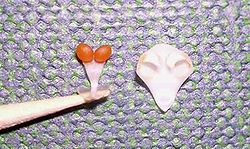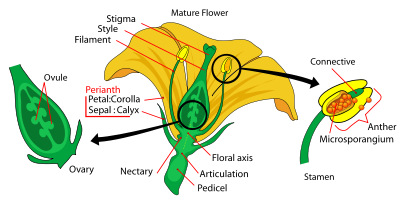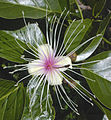- Stamen
-
For the Bulgarian physician, see Stamen Grigorov.
The stamen (plural stamina or stamens, from Latin stamen meaning "thread of the warp") is the pollen producing reproductive organ of a flower. Stamens typically consist of a stalk called the filament (from Latin filum, meaning "thread"), and an anther (from Ancient Greek anthera, feminine of antheros "flowery," from anthos "flower"), which contains microsporangia. Anthers are most commonly two-lobed and are attached to the filament either at the base or in the middle portion. The sterile tissue between the lobes is called the connective.
A typical anther contains four microsporangia. The microsporangia form sacs or pockets (locules) in the anther. The two separate locules on each side of an anther may fuse into a single locule. Each microsporangium is lined with a nutritive tissue layer called the tapetum and initially contains diploid pollen mother cells. These undergo meiosis to form haploid spores. The spores may remain attached to each other in a tetrad or separate after meiosis. Each microspore then divides mitotically to form an immature microgametophyte called a pollen grain.
The pollen is eventually released by the opening (dehiscence) of the anther, generally by means of longitudinal slits, but sometimes by pores, as in the heath family (Ericaceae), or by valves, as in the barberry family (Berberidaceae). In some plants, notably members of the Orchidaceae and the Asclepiadoideae, the pollen remains in masses called pollinia, usually specialised in ways adapted to being carried by particular pollinating agents such as birds or large insects. More commonly, mature pollen grains separate and are dispensed in ways suitable for wind or water transport, or for dusting onto pollinating insects, whether large or small.
When ready, the pollen is carried by some external agent (wind, water or some member of the animal kingdom) to the receptive surface of the carpel of the same or another flower. This process is known as pollination. After successful pollination, the pollen grain (immature microgametophyte) completes its development by growing a pollen tube and undergoing mitosis to produce two male gametes (sperm).[dubious ]
The stamens in a flower are collectively called the androecium (from Greek andros oikia: man's house). The androecium forms a whorl surrounding the gynoecium (carpels) and inside the perianth (the petals and sepals together) if there is one. (The one exception is a few members of the family Triuridaceae, particularly Lacandonia schismatica, in which the gynoecium surrounds the androecium.)
Stamens can be free or fused in various ways. A column formed from the fusion of multiple filaments is known as an androphore.
Contents
Descriptive terms
The anther can be attached to the filament in two ways:
- basifixed: attached at its base to the filament; this gives rise to a longitudinal dehiscence (opening along its length to release pollen)
- versatile: attached at its center to the filament; pollen is then released through pores (poricidal dehiscence).
Stamens can be connate (fused or joined in the same whorl):
- monadelphous: fused into a single, compound structure
- diadelphous: joined partially into two androecial structures
- synandrous: only the anthers are connate (such as in the Asteraceae)
Stamens can also be adnate (fused or joined from more than one whorl):
- epipetalous: adnate to the corolla
- didynamous: occurring in two pairs of different length
- tetradynamous: occurring as a set of six filaments with two shorter ones
- exserted: extending beyond the corolla
- included: not extending from the corolla.
Sexual reproduction in plants
Main article: Sexual reproduction in plants Stamen with pollinia and its anther cap. Phalaenopsis orchid.
Stamen with pollinia and its anther cap. Phalaenopsis orchid.
In the typical flower (that is, in the majority of flowering plant species) each flower has both carpels and stamens. In some species, however, the flowers are unisexual with only carpels or stamens. (monoecious = both types of flowers found on the same plant; dioecious = the two types of flower found only on different plants). A flower with only stamens is called androecious. A flower with only carpels is called gynoecious.
A flower having only functional stamens and lacking functional carpels is called a staminate flower, or (inaccurately) male.[1] A plant with only functional carpels is called pistillate, or (inaccurately) female.[2]
An abortive or rudimentary stamen is called a staminodium or staminode, such as in Scrophularia nodosa.
The carpels and stamens of orchids are fused into a column. The top part of the column is formed by the anther. This is covered by an anther cap.
Gallery
-
Insects collecting nectar unintentionally transfer pollen to other flowers, causing pollination
-
Flowers of wheat at anthesis showing stamens.
-
Stamens of a daylily (Hemerocallis), thickly covered in pollen
-
Flowers of the "silk tree" (Albizia julibrissin) have many long thread-like stamens
-
Stamens of a passion flower (Passiflora caerulea) showing interesting symmetry
-
Hylocereus undatus showing the style and stigma, and stamens
-
These Solanum anthers release pollen through a pore at their tip
-
Blue and red waterlily stamens deploying in the morning sun (Nymphaea caerulea
References
 This article incorporates text from a publication now in the public domain: Chisholm, Hugh, ed (1911). Encyclopædia Britannica (11th ed.). Cambridge University Press.
This article incorporates text from a publication now in the public domain: Chisholm, Hugh, ed (1911). Encyclopædia Britannica (11th ed.). Cambridge University Press.
Wikimedia Foundation. 2010.












